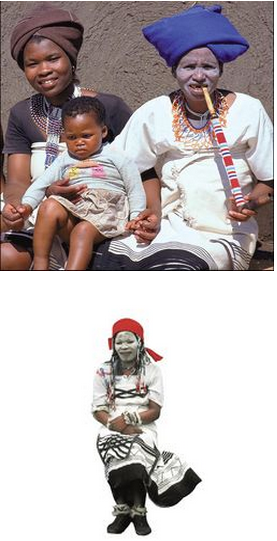 Xhosa women
Xhosa women
The Xhosa's are a proud people and their cultural heritage is close to their hearts. Traditionally, the women's clothing and ornaments show the stages of their lives. A certain headdress is worn by a newly married girl; a different style by one who has given birth to her first child, and so on. Women's clothing include dresses in bright colours like orange, green, red and white with braiding and beads over a skirt. The headdress is a colourful braided turban.
The Xhosa people are known for their beautiful beadwork and it forms an important part of women's traditional clothing. They wear long necklaces of beads, with collars of multi-coloured beads around the neck, as well as beaded arm and ankle bracelets.
Other beaded items include ithumbu (the elaborate bead necklace worn by Xhosa women when they perform a traditional dance or iqakabod), iqoqo (a decorative, tasselled and beaded band worn around the lower back), the vulwakabini (a beaded top worn over the upper body and breasts) and isidlokolo (an animal skin hat decorated with large beads and used by healers in traditional dance or when working with patients).
Xhosa women smoking decorative pipes is a familiar sight in some areas of the Eastern Cape. The pipes are usually made from wood and often decorated with beads
Xhosa men and boys
Xhosa men traditionally fulfilled the roles of warriors, hunters and stockmen. Animal skins formed an important part of their traditional clothing. Different animals skins were used, but royalty could use leopard skin. Xhosa men usually wear a covering in the front and a short cloak from animal skin over the shoulders. The cloak is sometimes replaced with a blanket. Xhosa men traditionally also wore animal skin sandals.
During initiation, Xhosa boys whiten their bodies and wear a blanket or sheepskin to ward off evil.
.



 Facebook
Facebook Twitter
Twitter WhatsApp
WhatsApp